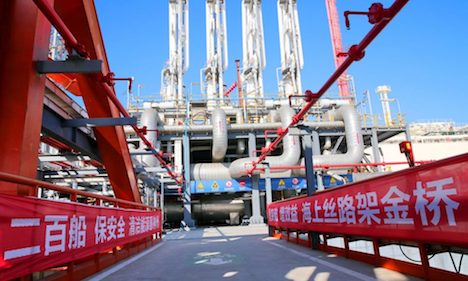‘Make Trade, Not War’ is China’s daring plan in the Middle East
 Print This Print This
By Pepe Escobar | Asia Times
Asia Times
Sunday, Jan 21, 2018
Under the Belt and Road Initiative, Beijing aims to connect western China to the eastern Mediterranean
 |
| An LNG terminal in Yangkou Port in Nantong city, which is in China's Jiangsu province. Photo: AFP |
China’s “Go West” strategy was brought into sharp focus at a forum in Shanghai last weekend. Billed as the Belt and Road Initiative: Towards Greater Cooperation between China and the Middle East, it highlighted key aspects of Beijing’s wider plan.
The New Silk Roads, or the Belt and Road Initiative, involve six key economic corridors, connecting Asia, the Middle East, North Africa and Europe. One, in particular, extends through the Middle East to North Africa. This is where the Belt and Road meets MENA or the Middle East and North Africa.
Of course, Beijing’s massive economic project goes way beyond merely exporting China’s excess production capacity. That is part of the plan, along with building selected industrial bases in MENA countries by using technical and production expertise from the world’s second-largest economy.
Again, this is will connect western China to the eastern Mediterranean. It will mean developing a corridor through projects such as the Red Med railway. There are also plans to expand ports, such as Oman’s Duqm, as well as substantial investment in Turkey.
A look at the numbers tells a significant part of the story. In 2010, China-Arab trade was worth US$145 billion. By 2014, it had reached $250 billion and rising. China is now the largest exporter to assorted MENA nations, while MENA accounts for 40% of Beijing’s oil imports.
The next stage surrounding energy will be the implementation of a maze of LNG, or liquefied natural gas, pipelines, power grids, power plants and even green projects, sprouting up across the new Silk Road corridors and transit routes.
According to the Asian Development Bank, the myriad of Belt and Road infrastructure projects for the next 15 years could hit a staggering $26 trillion. Other less grandiose figures come in at $8 trillion during the next two decades.
The ongoing internationalization of the yuan will be key in the process as will the role of the Asia Infrastructure Investment Bank (AIIB).
Naturally, there will be challenges. Belt and Road Initiative projects will have to create local jobs, navigate complex public and private partnerships along with intractable geopolitical wobbles.
Enseng Ho, a professor from the Asia Research Institute at the National University of Singapore, is one of an army of researchers studying how historical links will play an important role in this new configuration.
An excellent example is the city of Yiwu in Zhejiang province. This has become a mecca for merchant pilgrims from Syria or east Africa and has profited the region, according to the Zhejiang provincial government.
In a wider Middle East context, Beijing’s aim is to harness, discipline and profit from what can be considered an Industrialization 2.0 process. The aim is to help oil producers, such as Saudi Arabia and the rest of the Gulf states, diversify away from crude.
There is also reconstruction projections elsewhere, with China deeply involved in the commercial renaissance of post-war Syria.
As well as investing in its own future energy security, Beijing is keen to put together other long-term strategic investments. Remixing the centuries-old Chinese trade connections with the Islamic world fits into the Globalization 2.0 concept President Xi Jinping rolled out at last year’s World Economic Forum in the Swiss ski resort of Davos.
But then, Beijing’s strategy is to avoid a geopolitical collision in the Middle East. Its aim is to: Make Trade, Not War.
From the United States’ point of view, the National Security Strategy document highlighted how China and Russia are trying to shape a new geopolitical environment in the region, which contrasts sharply from Washington’s aims and interests.
It pointed out that while Russia is trying to advance its position as the leading political and military power broker, China is pushing ahead with a “win, win” economic policy. In 2016, that was spelt out in Beijing’s first Arab Policy paper, with its emphasis on bilateral trade cooperation, joint development projects and military exchanges.
Since geopolitical wobbles are never far below the surface in the Middle East, China has even suggested it would be willing to act as a mediator between intractable rivals Iran and Saudi Arabia.
Indeed, diplomacy is a key card for Beijing, according to Zhao Tingyang, a noted philosopher, at the Chinese Academy of Social Sciences.
In his 2006 paper, entitled Rethinking Empire from a Chinese Concept “All-Under-Heaven”, Zhao argued that the country show follow a principle of harmony based loosely on the Confucian notion of “all under heaven” or Tianxia in Mandarin.
Confucius, one would imagine, would be pleased by the Belt and Road Initiative. You could call it: “Make Trade, Not War All Under Heaven.”
Source URL
|
 Print This Print This

|

